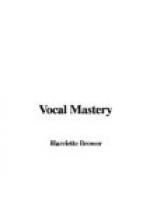“The management of the breath is a most important factor, as the life of the tone depends on the continuance of the breath. The student must cultivate the power of quickly inhaling a full breath and of exhaling it so gradually that she can sing a phrase lasting from ten to twenty seconds. This needs months of arduous practice. In all breathing, inhale through the nose. The lower jaw during singing should be entirely relaxed.
“The tone should be focused just back of the upper front teeth. The way to place the tone forward is to think it forward. The student must think the tone into place.
“To ‘attack’ a tone is to sing it at once, without any scooping, and with free open throat. When the throat is tightened the student loses power to attack her tones in the right way.
PHRASING
“Phrasing, in a limited sense, is simply musical punctuation. In its broader sense it is almost synonymous with interpretation. For it has to do not only with musical punctuation but with the grouping of tones and words in such a way that the composition is rendered intelligible as a whole, so as to express the ideas of the composer. This is where the intellectual and musical qualities of the singer are brought into requisition. She must grasp the content, whether it be song or aria, in order to effect this grouping intelligently. Accent, crescendo and diminuendo are the most important factors in phrasing. From the very beginning the student should be careful how and where she takes breath and gives accent; there must always be a reason, and thought will generally make the reason clear.
TONE PRODUCTION
“The first thing to be considered is the position of the body; for beauty of tone cannot be obtained unless all efforts harmonize to produce the desired result. An easy, graceful, buoyant position is essential; it can be cultivated in front of a mirror, from the first lesson.
“Tone production is the result of thought. Picture to yourself a beautiful tone; sing it on the vowel Ah. If you stood in rapture before an entrancing scene you would exclaim, Ah, how beautiful. Producing a beautiful tone rests on certain conditions. First, breath control; Second, Freedom of throat; Third, Correct focus of tone.
“We know that a stiff jaw and tongue are the greatest hindrances to the emission of good tone. Muscles of chin and tongue must be trained to become relaxed and flexible. Do not stiffen the jaw or protrude the chin, else your appearance will be painful and your tones faulty.
“To think the tone forward is quite as important as to sing it forward. Without the mental impression of correct placing, the reality cannot exist. It is much better to think the tone forward for five minutes and sing one minute, than to practice the reverse. One should practice in fifteen-minute periods and rest at least ten minutes between. The student should never sing more than two hours a day—one in the morning and one in the afternoon. As most singers love their work, many are inclined to overdo.




